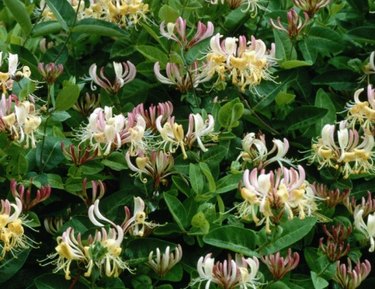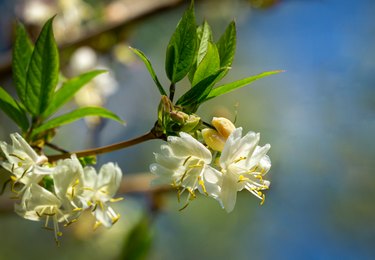
The over 180 honeysuckle vine varieties are easy-going plants that require little attention yet give back in abundance. Honeysuckle (Lonicera) pollinators are attracted to the flowers' sweet-tasting nectar, and their soft fragrance enhances any garden. Some varieties are deciduous, and others are evergreen, depending on where they are bred and grown, and you'll find a honeysuckle growing successfully in every American state. Fertilizers for honeysuckle vary as to nutritional composition depending on the soil, but all should be evenly balanced and applied infrequently.
Tip
If fertilizer doesn’t promote blooming on your honeysuckle, try giving it a hard prune and move it away from the north side of your home if it’s in a container. It needs the gentle eastern sun to flower.
Video of the Day
Honeysuckle Vine Varieties
As versatile as the honeysuckle is, growing zones for specific varieties are more particular. All grow best in U.S. Department of Agriculture hardiness zones 4-9, and you'll find an abundance of Japanese honeysuckle (Lonicera japonica) with its vibrant red and pink summer and autumn blossoms in the Midwest, along with the trumpet honeysuckle (Lonicera sempervirens) displaying its red and pink flowers in the spring in the Southeast.
Video of the Day

The extremely fragrant white winter honeysuckle (Lonicera fragrantissima) offers whiffs of lemon emitting from its flowers. It is considered an invasive noxious weed and the midwestern states do not recommend cultivating this honeysuckle variety. If your garden is primarily shade, but you still want the fragrance of a honeysuckle, plant a Lonicera ciliosa that thrives in the shade and tolerates cooler temperatures. All varieties aren't specific as to soil type as long as they are given ample water, occasional fertilizer and enough sun to promote flowering during their blooming season.
Fertilizing Honeysuckle to Promote Flowering
If your honeysuckle is young and isn't flowering, be patient. A new vine takes up to 3 years to blossom and, as the plant can live up to 20 years, you'll see plenty of showy display during its lifetime. Let a young plant settle in before fertilizing as it adjusts to the soil. A fertilizer with a higher first number than the others (the "N" of NPK) contains nitrogen that encourages pests, while a lower first number encourages blooming. Regular maintenance in well-balanced soil includes a shot of slow-release organic fertilizer in the spring. Composted manure also adds to the nutrients fed to the vine.
Pruning is the best control for the fast-growing vine, but be sure you aren't cutting away newly formed buds. Research your type of honeysuckle to determine the best pruning method and cut in the fall or winter, when the plant goes dormant. Some gardeners prefer to use the honeysuckle for erosion control and to forego pruning.
Honeysuckle Care for Best Results

Planted in a container or as the background for a garden, honeysuckle needs to be tethered to a trellis. It doesn't have suckers that grab onto a wall or support so it must be tied loosely so as not to strangle the vine. Place the trellis at least 6 inches from the plant itself. If you grow your honeysuckle in a container, supplement the soil with perlite as drainage is important, and be sure drain holes are drilled into the bottom. Water more if your honeysuckle is in an open garden but beware of over-watering, and don't let the water touch the leaves to minimize fungal growth.
After planting, add an inch of mulch around the plant but not touching its base. Container-grown honeysuckle may need a second dose of fertilizer during the growing season. Monitor the budding to determine the fertilization needs.